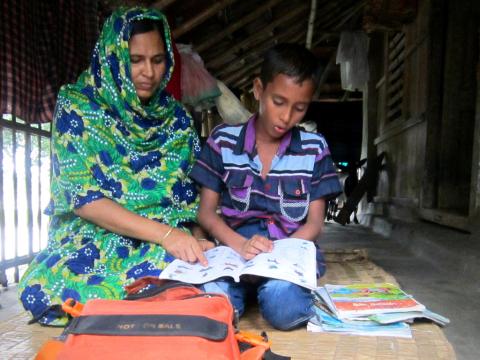Knowledge for life: Tips to predict and prepare for a disaster from a 9-year-old

Al-Amin is 9 years old from Bangladesh. This story is from his perspective.
When my grandmother was fixing our house, I asked her why she was raising the ground level. She said it was to protect us from floods.
She told me that our country is prone to storms, cyclones and tidal surges which can result in a flood. She said that floods are the most common type of of disaster in our country and can affect many people’s lives.
If we’re flooded, we could lose our houses, livestock, other assets or even our lives. So I asked her what we can do to avoid this. She told me that nature is predetermined and we can’t control it, but if we take some safety measures we can reduce the effect of a natural disaster.
That day I learned about many precautions that can be taken to face a disaster, like constructing houses and animal pens by taking into account the high flood level and avoiding wetlands, preparing a banana-tree raft and keeping a portable burner for emergency travel, planting bamboo and banana trees around the house to face cyclones and always storing some dry food and clean water for emergencies.
I learned another interesting piece of information from my grandmother, which was that people living in coastal regions usually avoid building south-facing homes to protect themselves from cyclones.
I wanted to know about the signs of disasters. I was really eager to know how we can be sure a disaster is knocking on our door.
My grandmother told me that nowadays, with new technology, it’s very easy to know about disasters from the news on TV and the radio; but once it was really tough and we used to predict one by looking at the clouds position, and also the colour of the sky. The wind direction is also a vital factor.
Something that really surprised me was that my grandmother can predict a disaster by the movements of birds in the sky. Ants also search for a safe place when disaster is on it’s way. My grandmother told me that a disaster can be predicted through tidal effects in the river as well.
In modern life, although everything has become faster and we can get information easily through technological equipment, these traditional methods have worked for our ancestors for many years, allowing them to prepare for disasters.
I am a sponsored child in Bangladesh, and I’ve learned many safety measures from discussions in the monthly meetings. My mother is an active member of one of our community-based organisations, so she is well trained in taking precautions for disasters.
She made me understand that although we can’t control the flow of nature, our unconscious actions can be a major cause of climate change, which is one of the vital issues related to disasters. I know that using an environmentally friendly stove and solar panels are measures to fight climate change.
Apart from that, we should plant many trees that can help protect our environment. I’ve seen farmers are using floating gardening technology and growing crops that are tolerant to saltwater and adapted to the climate, which are more important initiatives to resist climate change.
A disaster risk reduction plan is also being developed by the community and people know about using megaphones, microphones and mobiles to broadcast emergency messages in remote areas.
From what my grandmother has taught me, I believe that modern technology alone is not enough to overcome a disaster, but combined with traditional practices we can be well-equipped to overcome one.